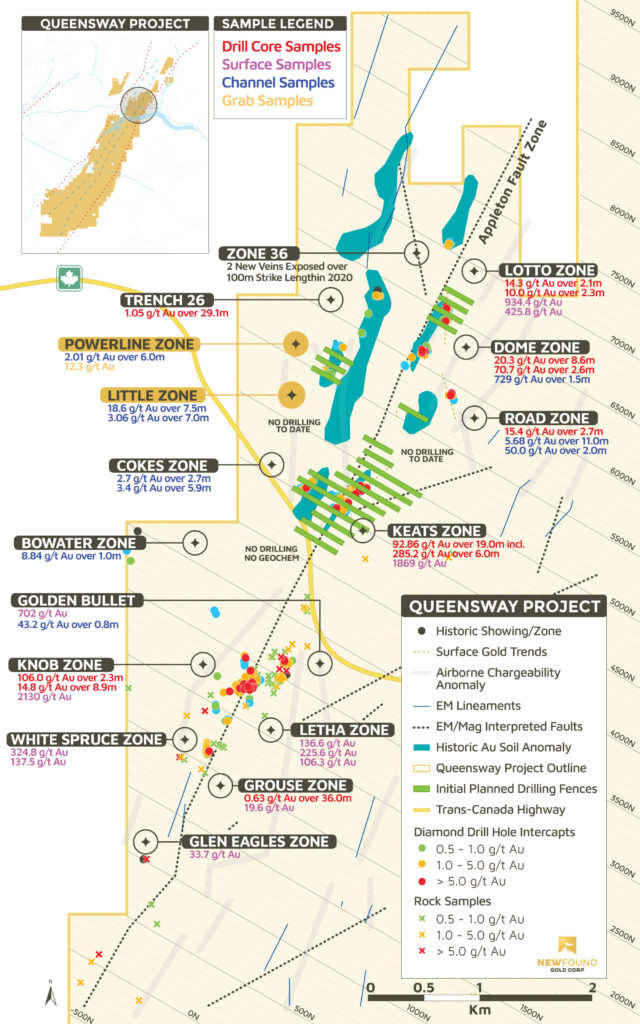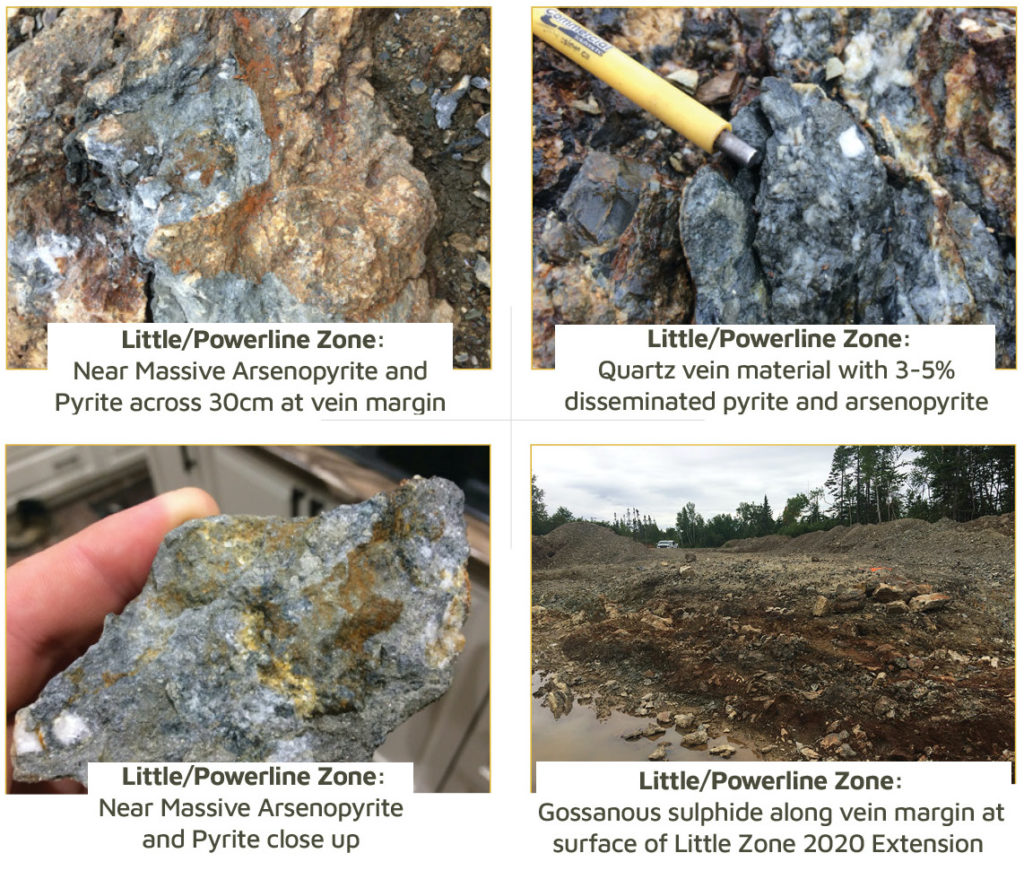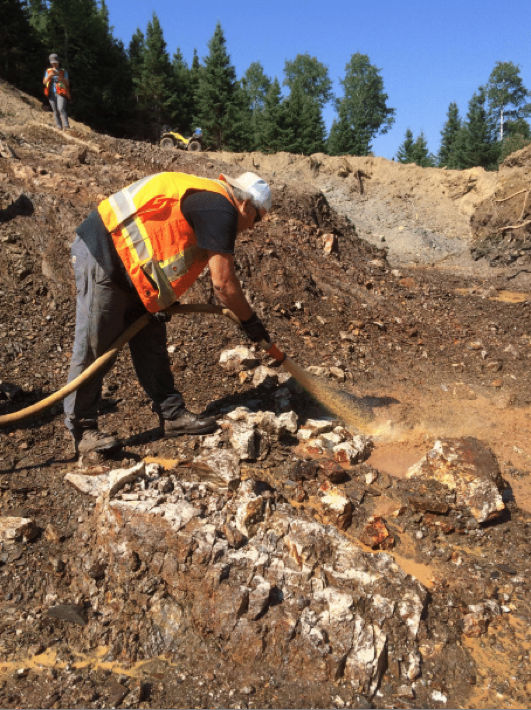New Found Gold Commences 100,000-Meter Drill Program at Queensway Project, Newfoundland
Vancouver, BC – August 17, 2020, New Found Gold Corp. (“New Found” or the “Company”) (TSXV: NFG) is pleased to announce it has commenced drilling at its Queensway Project, located in Central Newfoundland.
Highlights:
- Diamond drilling commenced at the Little/Powerline Zone, along the Appleton Fault Zone, on Monday, August 17 (see Figure 1).
- An initial six holes (800 m) are planned at the Little/Powerline Zone to follow up on surface mapping and sampling including a channel sample of 18.6 g/t Au over 7.5 meters.
- Following completion of the initial six holes at Little/Powerline the first drill will be moved to the Keats Zone to follow up on the discovery intercept of 19.0 m of 92.9 g/t gold starting at 96 m down hole. An initial 12,000 m of drilling is planned at Keats.
- The Company plans to ramp up to 4 drills by the end of September resulting in approximately 2,000 m per week of core production.
- Drill plans are now developed for seven additional gold bearing targets: 1744, Pocket Pond, Logan/Lochlan, Zone 36, Lotto, Road, and Cokes Zones (see locations on Figure 1).
- Recent trenching has uncovered new mineralization in three areas with one new zone (Zone 36) demonstrating visible gold coincident with mineralization and textures typical of epizonal type mineralization. Zone 36 is located 2.5km north of discovery hole NFGC-19-01, along the Appleton Fault structure (see Figure 1).
Collin Kettell, Executive Chairman of New Found, stated: “We are excited to begin our 100,000 m drill program at Queensway. Historical exploration has confirmed there are multiple near surface high-grade gold targets along 5 km of the Appleton Fault Zone trend and we are planning to grid drill much of this 5 km long target area.”
Craig Roberts, P.Eng., Chief Executive Officer, stated: “New Found is well advanced with the logistical infrastructure to support this major drilling program. We have purchased a seven-thousand square foot warehouse in Gander for core logging and processing and are outfitting it now. Additionally, we are finalizing the purchase of a one-acre industrial site where we will install core storage sheds. Our 30-plus person exploration team has been working in the field since June to advance and refine targeting ahead of the drill program.”

Figure 1: Multiple showings and zones along 5 kilometers of the Appleton Fault Zone, including drill samples, surface samples, channel samples, grab samples
Little/Powerline Zone Target, Appleton Fault Zone
The Little/Powerline Zone was discovered by trenching in 1999 based on soil geochemistry and prospecting. The zone is defined by a 400m long soil anomaly with some of the highest soil values on the Queensway North area with up to 3,840ppb Au.
Channel sample results from 1999 include 18.6 g/t Au over 7.5m and 3.0 g/t Au over 7.0m. Mineralization occurs within and along the margins of several parallel vein sets with up to 15% sulfide mineralization (arsenopyrite and pyrite). A new trench was recently completed at Little/Powerline by New Found extending the surface exposure of the zone by 35m. The zone shows considerable width of mineralization with good continuity along the 70m of strike exposed by trenching to date. A strong EM conductor coincident with the veining extends for over 200m north of the surface exposure following the high gold in soil anomaly (see Figure 2).
The drilling now underway at the Little/Powerline Zone will initially test this target over 200m of strike length.

Figure 2: Planned drill holes at the Little/Powerline Zone

Planned Drilling on other Appleton Fault Zone Targets
Following the completion of six holes at Little/Powerline the drill will be moved to the Keats Zone to follow up on hole NFGC-19-01 drilled by New Found in late 2019. NFGC-19-01 intersected 19.0 m of 92.9 g/t gold starting at 96 m down hole (this intercept has an estimated true width of 70%). Drill targets and plans are now also developed for the 1744, Pocket Pond, Logan/Lochlan, Zone 36, Lotto, Road, and Cokes Zones (see Figure 1 above). Drilling will proceed sequentially on these targets as additional drills are added.
Appleton Fault Zone Trenching Program
Starting in early July 2020 the Company began with the excavation of surface targets along the Appleton Fault Zone. To date eleven trenches have been opened-up with overburden cleared to allow geological mapping and sampling. Several new zones or extensions of mineralization have now been exposed: Zone 36, Regular Trench, Hornet, Little, and Road.
In late July, the Company exposed a new vein with over 120m strike length, named Zone 36. It comprises a north-west trending set of two parallel veins west of the Appleton Fault primary EM contact. Chalcopyrite, arsenopyrite, pyrite, boulangerite and visible gold have been found along the veins, with some areas exhibiting mineralization and textures consistent with epizonal style mineralization.

Trench 36, exhibits mineralization and textures consistent with epizonal deposition
Covid-19 Protocols
The Company has strict Covid-19 protocols including a 14-day mandatory isolation on arriving on the island. A significant portion of New Found’s operating personnel are from Gander. New Found is renting two houses in Gander for staff who are not locally based. The Company is focused on hiring locally and does not allow fly in, fly out arrangements for outside personnel.
QA/QC
True widths of the new exploration intercepts reported in this press release have yet to be determined but are estimated to typically be 70%-80% of reported core lengths; all channel sample true widths are estimated to be close to the reported widths. Assays are uncut, and calculated intervals are reported over a minimum length of 2 metres using a lower cutoff of 3.0 g/t Au. All HQ core assays reported were obtained by either whole sample rock metallic screen/fire assay or standard 30-gram fire-assaying with ICP finish at ALS Minerals in Vancouver, British Columbia. The whole sample metallic screen assay method is selected by the geologist when samples contain coarse gold or any samples displaying gold initial fire assay values greater than 1.0 g/t Au. Drill program design, Quality Assurance/Quality Control and interpretation of results is performed by qualified persons employing a Quality Assurance/Quality Control program consistent with NI 43-101 and industry best practices. Standards and blanks are included with every 20 samples for Quality Assurance/Quality Control purposes by the Corporation as well as the lab. Approximately 5% of sample pulps are sent to secondary laboratories for check assays.
Qualified Person
The technical content disclosed in this press release was reviewed and approved by Greg Matheson, P.Geo., Chief Operating Officer and a Qualified Person as defined under National Instrument NI 43-101.
About New Found Gold Corp
New Found holds a 100% interest in the Queensway Project, located 15 km west of Gander, Newfoundland. The project is intersected by the Trans-Canada Highway, is located just 18 km from Gander international airport, has logging roads crosscutting the project, has high voltage electric power lines running through the project area, and easy access to a highly skilled workforce. With working capital of approximately C$75 million the Company is well financed for aggressive exploration with an initial planned drill program of 100,000 meters. New Found has a proven capital markets and mining team with major shareholders include Palisades Goldcorp (33%), Eric Sprott (18%), Novo Resources (11%), Rob McEwen (7%), other institutional ownership (8%), and management, directors and insiders (4%). Approximately 65% of the Company’s issued and outstanding shares are subject to escrow or 180-day lock up agreements. Please see the Company’s website at www.newfoundgold.ca and the Company’s SEDAR profile at www.sedar.com.
Acknowledgments
New Found acknowledges the financial support of the Junior Exploration Assistance Program, Department of Natural Resources, Government of Newfoundland and Labrador.
Contact
To contact the Company please visit the Company’s website at www.newfoundgold.ca and make your request through our investor inquiry form. Our management has a pledge to be in touch with any investor inquiries within 24 hours.
New Found Gold Corp.
Per: “Craig Roberts“
Craig Roberts, P.Eng., Chief Executive Officer
Neither the TSX Venture Exchange nor its Regulation Services Provider (as that term is defined in the policies of the TSX Venture Exchange) accepts responsibility for the adequacy or accuracy of this release.
Forward-Looking Statement Cautions:
This press release contains certain “forward-looking statements” within the meaning of Canadian securities legislation, relating to further the exploration and drilling on the Company’s Queensway gold project in Newfoundland. Although the Company believes that such statements are reasonable, it can give no assurance that such expectations will prove to be correct. Forward-looking statements are statements that are not historical facts; they are generally, but not always, identified by the words “expects,” “plans,” “anticipates,” “believes,” “intends,” “estimates,” “projects,” “aims,” “potential,” “goal,” “objective,” “prospective,” and similar expressions, or that events or conditions “will,” “would,” “may,” “can,” “could” or “should” occur, or are those statements, which, by their nature, refer to future events. The Company cautions that Forward-looking statements are based on the beliefs, estimates and opinions of the Company’s management on the date the statements are made and they involve a number of risks and uncertainties. Consequently, there can be no assurances that such statements will prove to be accurate and actual results and future events could differ materially from those anticipated in such statements. Except to the extent required by applicable securities laws and the policies of the TSX Venture Exchange, the Company undertakes no obligation to update these forward-looking statements if management’s beliefs, estimates or opinions, or other factors, should change. Factors that could cause future results to differ materially from those anticipated in these forward-looking statements include risks associated possible accidents and other risks associated with mineral exploration operations, the risk that the Company will encounter unanticipated geological factors, the possibility that the Company may not be able to secure permitting and other governmental clearances necessary to carry out the Company’s exploration plans, the risk that the Company will not be able to raise sufficient funds to carry out its business plans, and the risk of political uncertainties and regulatory or legal changes that might interfere with the Company’s business and prospects. The reader is urged to refer to the Company’s reports, publicly available through the Canadian Securities Administrators’ System for Electronic Document Analysis and Retrieval (SEDAR) at www.sedar.com for a more complete discussion of such risk factors and their potential effects.